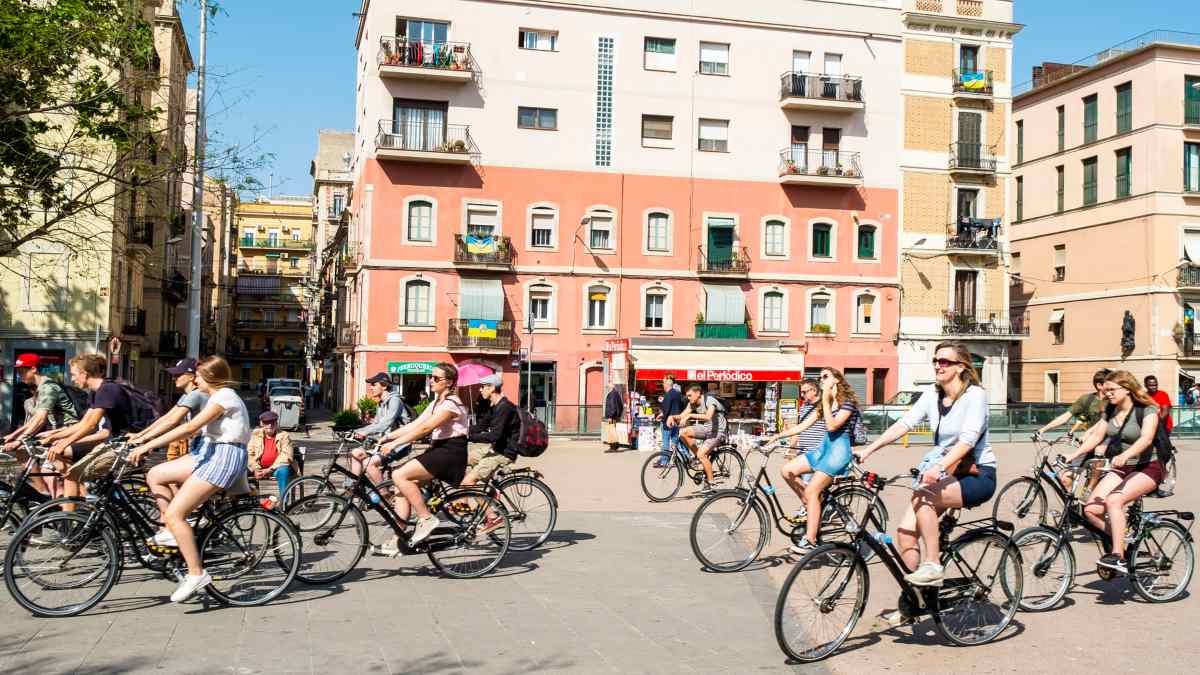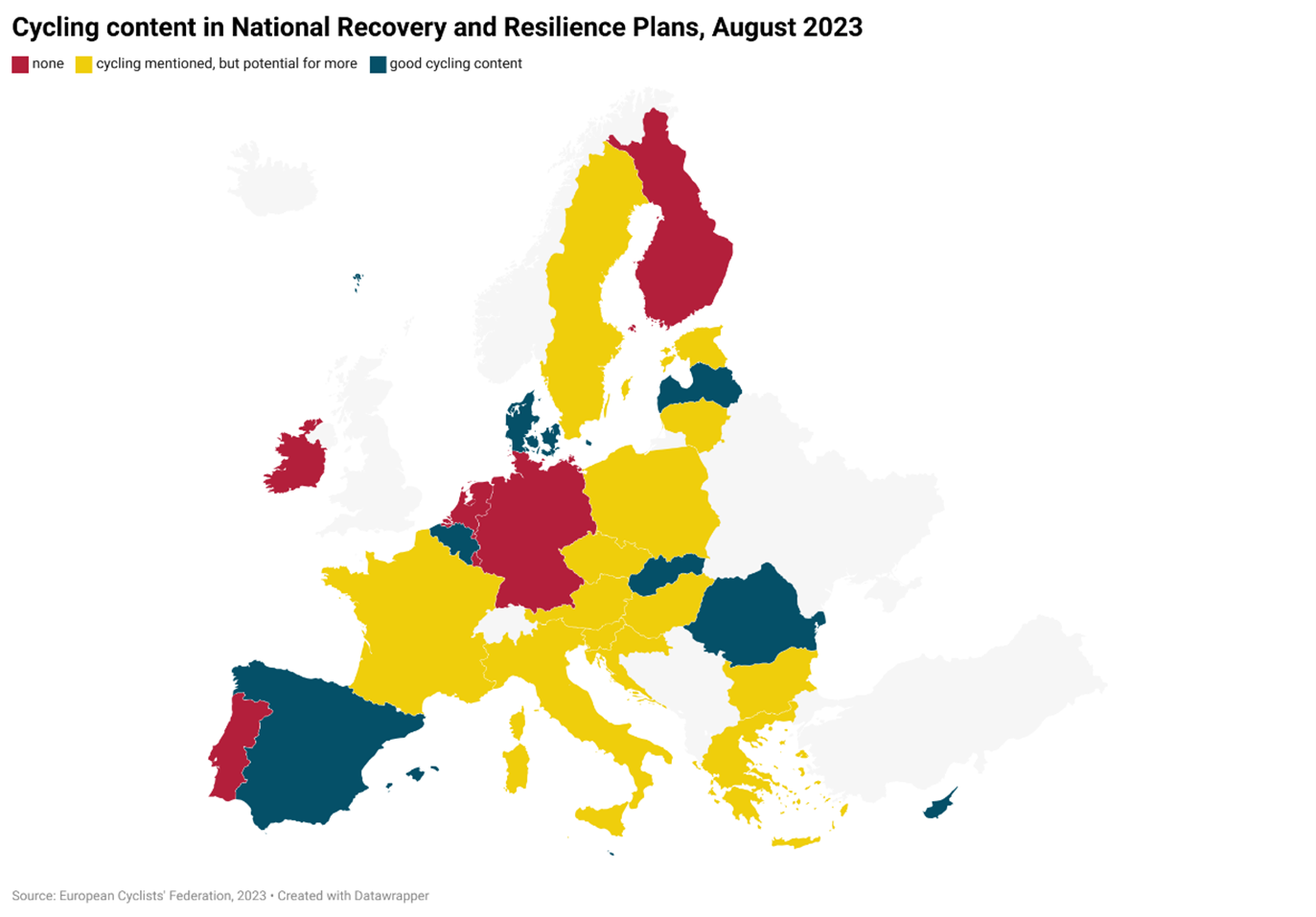
NextGenerationEU and cycling: Recovery investments being carried out across Europe, but Italy becomes problem child
With National Recovery and Resilience Plans in place for two years now, it is time again for ECF to check how cycling investments are progressing. Short answer: More or less as planned, except for Italy.
In 2021, EU Member States adopted their National Recovery and Resilience Plans (NRRPs) under the EU’s €800 billion “NextGenerationEU” stimulus package. Thanks to concerted advocacy efforts of ECF and its members, many national plans contained measures for and investments in cycling. At the time of adoption, we estimated investments in cycling in the NRRPs to reach €1.7 billion. In our latest assessment from the end of last year, we could increase this estimation to more than €2 billion, thanks to more increased investment commitments notably in Spain and Romania. Now, after more than €106 billion of grants under the Recovery and Resilience Facility have been disbursed to Member States (around one third of the total maximum grant amount), and the deadline of 2026 coming up for the disbursement of funds, it is time to take stock again.

The country that had proposed the most cycling investments in absolute terms in its NRRP, according to our analysis, was Italy, with investments of €600 million to finance the construction of 1,200 km of touristic cycle paths and around 570 km of urban cycling infrastructure until 2026. The planning processes for implementing these investments were well underway during our latest assessment, and the Italian government’s NRRP scoreboard indicates a completion percentage of 14% for urban cycling infrastructure and 14.5% for touristic cycling routes until June 2023, which seems to be appropriate given the time needed for planning, permits etc.
However, on 27 July 2023, the Italian government proposed a revision of the NRRP that would cut funding by two thirds and leave only €200 million for cycling investments. This has provoked an immediate reaction of a broad coalition of Italian NGOs active in the fields of sustainable mobility and environmental protection, including ECF member FIAB calling for all investments that are respecting the NextGenerationEU deadlines to be left intact. What is more, many Italian regions that would be affected by the cuts have criticised them at the highest level. The President of the Pulia region (member of ECF network Cities and Regions for Cyclists), Michele Emiliano, stated: “All the tenders for cycle routes - I heard President Marsilio [of the Abruzzo region] say the same thing - are basically ready: Why block them? Why cut by categories and not by individual calls for tenders?” In the upcoming negotiations on the revision of NRRPs, the regions and associations will hopefully be able to make their voice heard and prevent funding cuts that would greatly damage the development of active mobility and the sustainable mobility transformation in Italy.
There is also an example showing that a proposed revision of the NRRP can be beneficial for cycling: Spain. Already in our last assessment, we saw that the commitments in the original plan were being made more concrete, with €500 million being mobilised for cycling. The revision proposal for the plan, which was submitted to the European Commission in June 2023, does not include specific additional investments, but a number of regulatory updates that could have a positive impact for cycling:
- A sustainable mobility law which will regulate activities related to transport and mobility, including issues related to planning and financing of transport infrastructure and services, improving governance, alternative fuels, inclusive mobility, fostering innovation and digitisation, improving transparency and accountability. The draft of the law, which is supposed to be adopted during 2023 but might be postponed because of snap elections in July 2023, includes a “right to a sustainable and equitable mobility system” which facilitates access to active and sustainable mobility.
- Strengthening the Spanish system for planning and investment in transport infrastructure, by developing a cost/benefit analysis methodology applicable in the process of evaluation of state investments in transport infrastructure, allowing the comparison and prioritisation of planned actions from an intermodal perspective, as well as the ex-post evaluation of the investments made. It will pay special attention to greenhouse gas emissions and other pollutants and will include a carbon footprint calculation.
- Royal Decree regulating low emission zones. The Royal Decree implements the mandate of the Climate Change Law to create low-emission zones in municipalities with more than 50,000 inhabitants and island territories: It establishes the minimum requirements to be met by these Low Emission Zones, providing legal certainty among users, companies and citizens in general with the aim of reducing emissions of Greenhouse Gases and other atmospheric pollutants.

While the proposal was made by the previous government before the national elections in July 2023, any new government that is formed will hopefully honour these commitments to sustainable mobility.
Another country that has made investments in cycling one of the focal points of its NRRP is Belgium, with a total amount of €400 million in investments. The region of Flanders, where most of the investments are planned, provides detailed data on the implementation of the projects:
- For regional projects, 38% of infrastructure improvement projects and 3% of new construction projects have been realised so far.
- For local projects, where municipalities in a first step had to apply for subsidies, 46% of the goal for infrastructure improvement projects was achieved. However, this was more than compensated for by the fact that municipalities applied for eight times more kilometres of new infrastructure to be built than originally planned. In total, projects for 1,036 km of new or improved infrastructure were handed in, slightly more than the 1,018 km originally planned. These projects will have to be completed by 2025.
The projects of the Brussels (€34 million) and Walloon (€14 million) regions are also on their way according to the Belgian federal recovery scoreboard.
Finally, also Romania seems to be on its way to implement the planned substantial investments from its NRRP. According to the latest news, more than €210 million have been approved for three large projects in the country:
- The partnership between the county councils of Timiș, Arad, Caraș Severin and Hunedoara received most funding. The project will receive €142 million, excluding VAT, for 1,729 km of cycle routes.
- The partnership between Suceava, Bistrița-Năsăud and Mureș County councils will receive a funding of €40.7 million, excluding VAT, to develop 494 km of cycling routes.
- In the South, the partnership between the counties of Dolj, Olt and Mehedinți will receive €29.3 million without VAT to build a 365 km cycling route.
Contact the author
Recent news!
Contact Us
Avenue des Arts, 7-8
Postal address: Rue de la Charité, 22
1210 Brussels, Belgium









